| |
OBJECTIVES |
|
Structural analysis and calculations - The thrust line applied to the arch of the Old Bridge of Mostar.
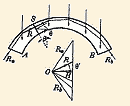
|
get it
 |
| xxx |
ARCH
F.E.M. |
|
F.E. model of the arch
After the preliminary analysis,
more
accurate structural analyses have been performed, starting with the
creation of a F.E. model of the arch

|
get it  |
-xxx |
BRIDGE
F.E.M. |
|
F.E. model of the whole bridge
In the second stage the
Ansys calculation code was adopted. This programme enables to perform
non-linear analyses of the structure. The F.E. model has been created
with the available data.
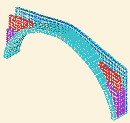
|
get it  |
| -xxx |
LOADS |
|
Load conditions and combinations
The load conditions and combinations were defined
according to Eurocode 1, in particular to Part 3 (ENV 1991-3: 1994) which
refers to the definition of the pedestrian, cycle action and other actions
specifically for footbridges.
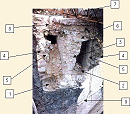
|
get it  |
| -xxx |
LOADS
& PARAMETERS |
|
Load combinations - Soil characteristics at the abutments - Values of the material parameters assumed in the design - Elasticity modulus of the masonry
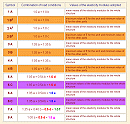
|
get it
 |
| -xxx |
STRESSES
AND LOAD COMB. 3A |
|
Stresses in the bridge - Load combination 3A
- 1,35 permanent loads + 1,35 traffic
loads on the whole bridge
- mean values of the elasticity
modulus for the whole structure

|
get it
 |
| xxx |
LOAD
COMB. 3B |
|
Load combination
3B
- 1,35 permanent loads + 1,35 traffic
loads on the whole bridge
- maximum value of the elasticity
modulus for the arch and minimum value for the other structural
elements

|
get it
 |
| xxx |
LOAD
COMB. 5A |
Load combination
5A
- 1,35 permanent loads + 0,54 traffic
loads on the whole bridge + 1,5 uniform thermal variation of +15
�C
- mean values of the elasticity
modulus for the whole structure

|
get it
 |
| xxx |
LOAD
COMB. 5B |
Load combination
5B
- 1,35 permanent loads + 0,54 traffic
loads on the whole bridge + 1,5 uniform thermal variation of +15
�C
- maximum values of the elasticity
modulus for the whole structure

|
get it
 |
| xxx |
LOAD
COMB. 6A |
Load combination
6A
- 1,35 permanent loads + 0,54 traffic
loads on the whole bridge + 1,5 uniform thermal variation of -15
�C
- mean values of the elasticity
modulus for the whole structure

|
get it
 |
| xxx |
|
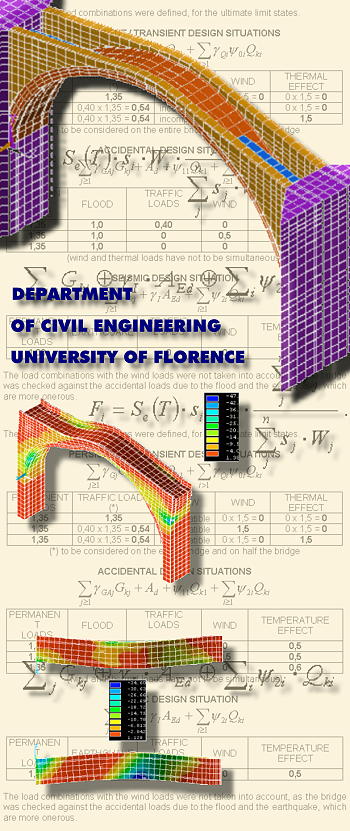
DEPARTMENT
OF CIVIL ENGINEERING UNIVERSITY
OF FLORENCE
work
group:
-
Prof.
Ing. Andrea Vignoli
-
Prof.
Ing. Paolo Spinelli
-
Prof.
Ing. Franco Angotti
-
Prof.
Ing. Fabio Selleri
-
Prof.
Ing. Fabio Castelli
-
Ing.
Ph.D. Maurizio Orlando
-
Ing.
Cristiano Casamaggi
training
staff:
credits:
Intellectual property of
the structural design is owned by the University of Florence - Department of
Civil Engineering
|
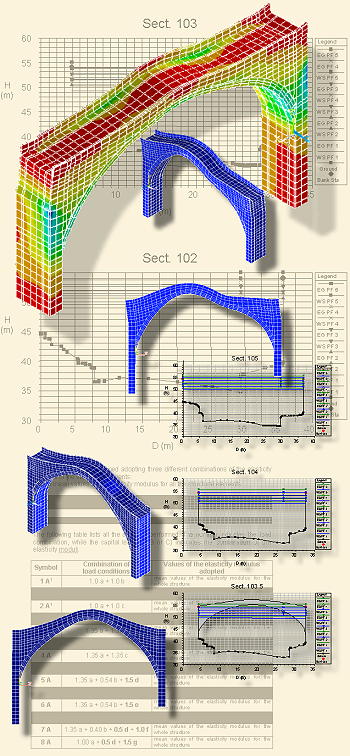
|
Structural analysis and calculations
The structural calculations of Stari Most were
performed to evaluate the maximum stresses in the structure produced by
the design loads and the maximum deflections produced by the loads during
the working phases.
The following loads were considered: permanent loads,
live loads, thermal loads, accidental loads due to the flood and to the
earthquake.
The check of the structure against the earthquake
actions was made determining the peak acceleration which produces the
collapse of the structure.
In the fisrt part of this report some notes have been
taken on the basis of a preliminary and simplified geometry of the bridge,
then, in the second part, more accurate investigations have been performed
on the "most likely bridge shape".
|
|
| |
LOAD
COMB. 6B |
|
Load combination
6B
- 1,35 permanent loads + 0,54 traffic
loads on the whole bridge + 1,5 uniform thermal variation of -15
�C
- maximum values of the elasticity
modulus for the whole structure

|
get it
 |
| -xxx |
LOAD
COMB. CHARTS |
|
The following tables list the maximum stresses of the
arch and of the spandrels in all the load combinations considered.
|
get it
 |
| -xxx |
THRUST
AT THE ABUTMENTS |
| Diffusion of the thrust at the abutments - Stresses
sx - Left abutment - Load combination no. 1B - Stresses
sx - Right abutment - Load combination no. 1B
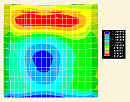
|
get it
 |
| --xxx |
|
STRESS
sx |
| Stresses sx - Left abutment - Load combination no. 5C - Stresses
sx - Right abutment - Load combination no. 5C

|
get it
 |
| xxx |
|
STRESS
sy |
| Locations of the horizontal sections - Stresses
sy - Left abutment - Load combination no. 5C - Stresses
sy - Right abutment - Load combination no. 5C

|
get it
 |
| xxx |
FLOOD
FORCE |
|
Load combination with the flood force
The flood produces a total
shear much higher than the shear produced by the seismic actions, but the
stresses and strains are lower than those produced by the earthquake,
because the flood force is concentrated prevalently on the lateral sides
of the bridge.
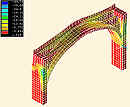
|
get it
 |
| xxx |
SEISMIC
ACTIONS |
|
Load combination with the seismic actions.
The structural behaviour of the bridge
under the seismic actions has been studied taking into account the
non-linear behaviour of the masonry, as it was done for the flood force.
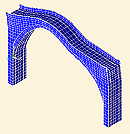
|
get it
 |
| xxx |
SEISMIC
ANALYSIS RESULTS |
| Results of the seismic analysis - Results for the load combination with prevailing earthquake along Z - Results for the load combination with prevailing earthquake along X - Results for the load combination with prevailing earthquake along Y
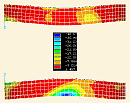
|
get it
 |
| xxx |
CONSTRUCTION
PHASES |
| Deformations of the structure during the construction
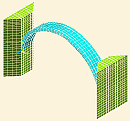
|
get it
 |
| xxx |
LOADS
OVER THE CENTERING |
| Loads acting on the centering:
The following table lists the loads acting on the centering during the
work phases. |
get it
 |
| xxx |
STRENGHT
OF ARCH MASONRY |
Required strength of the arch masonry: The strength of a masonry does not depend only upon the strength of the blocks, but also upon the strength of the mortar, the thickness of the mortar layers and the height of the blocks.
Therefore, the required strength of the stones for the arch cannot be chosen leaving out of consideration these parameters. |
get it
 |
| xxx |
|